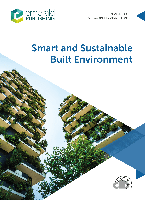
Smart and Sustainable Built Environment
Scope & Guideline
Exploring the intersection of sustainability and architecture.
Introduction
Aims and Scopes
- Sustainability Assessment:
The journal explores methodologies and frameworks for assessing sustainability in various aspects of the built environment, including materials, energy use, and overall environmental impact. - Digital Technologies in Construction:
A core focus is on the application of digital technologies such as Building Information Modeling (BIM), digital twins, and the Internet of Things (IoT) to enhance construction processes, improve efficiency, and reduce waste. - Circular Economy Practices:
The journal promotes research on circular economy strategies within the construction sector, including the reuse of materials, waste management, and innovative design approaches that facilitate resource efficiency. - Urban Resilience and Smart Cities:
Research related to urban resilience, smart city development, and sustainable urban planning is a key area, emphasizing how cities can adapt to challenges such as climate change and rapid urbanization. - Stakeholder Engagement and Social Sustainability:
The journal also addresses the importance of stakeholder engagement in sustainable development, exploring how community involvement and social equity can be integrated into construction and urban planning.
Trending and Emerging
- Digital Twin Technology:
The application of digital twin technology is increasingly prominent, with research focusing on its role in urban planning, construction management, and sustainability assessments. - Circular Economy Innovations:
There is a growing emphasis on innovative strategies for implementing circular economy principles in construction, including the development of new materials and waste management practices. - Integration of AI and Machine Learning:
The integration of artificial intelligence and machine learning in construction processes, such as predictive maintenance and project management, is a significant area of interest, reflecting the industry's push toward smarter solutions. - Urban Heat Mitigation Strategies:
Research on urban heat island mitigation and the role of green infrastructure in enhancing urban resilience is gaining momentum, highlighting the intersection of climate adaptation and sustainable design. - Sustainable Mobility and Infrastructure:
Emerging studies are increasingly addressing the nexus of sustainable mobility and urban infrastructure, exploring how transportation solutions can be integrated into smart city frameworks for improved sustainability.
Declining or Waning
- Traditional Construction Methods:
There is a noticeable decrease in research focused on traditional construction methods, as the industry increasingly shifts towards innovative and technology-driven approaches. - General Green Building Practices:
Research that broadly addresses green building practices without specific technological or strategic context is becoming less frequent, as more targeted studies on digital and circular economy strategies emerge. - Impacts of COVID-19 on Construction:
As the pandemic's immediate effects recede, studies specifically analyzing the impacts of COVID-19 on construction practices and policies are less common, leading to a waning interest in this area.
Similar Journals
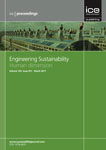
Proceedings of the Institution of Civil Engineers-Engineering Sustainability
Transforming Ideas into Sustainable Engineering SolutionsProceedings of the Institution of Civil Engineers - Engineering Sustainability is a distinguished journal published by Emerald Group Publishing Ltd, focusing on the intersection of civil engineering and sustainability practices. As a Q3 category journal in the field of Civil and Structural Engineering, it offers a critical platform for professionals, researchers, and students to share innovative research that addresses global environmental challenges from 2004 to its forthcoming issues in 2024. With an ISSN of 1478-4629 and E-ISSN of 1751-7680, this journal aims to disseminate vital knowledge regarding sustainable engineering solutions and practices, thereby fostering awareness and prompting action within the discipline. Although not an Open Access journal, it maintains a strong connection to academic and practitioner communities, ensuring high visibility and accessibility through its rigorous peer-review process. Its current Scopus rank places it in the 58th percentile, underscoring its relevance and contribution to the civil engineering domain.

Gradevinar
Unlocking Access to Cutting-Edge Engineering InsightsGradevinar, published by the Croatian Society of Civil Engineers-HSGI, is a leading Open Access journal in the field of Civil and Structural Engineering, with a significant history that dates back to its inception in 1980. This journal, with the ISSN 0350-2465 and E-ISSN 1333-9095, has established itself as a vital platform for disseminating innovative research and practical developments in civil engineering, particularly since it became Open Access in 2000, facilitating unrestricted access to its wealth of knowledge. As of 2023, Gradevinar is ranked in the third quartile (Q3) of Scopus’s Civil and Structural Engineering category, demonstrating its growing influence and relevance in the academic community, with a current ranking of #255 out of 379 journals in the field. Researchers, professionals, and students benefit from this journal's commitment to high-quality content that reflects the latest advancements and best practices in civil engineering, contributing to both technical proficiency and sustainable development in infrastructure projects across Croatia and beyond.
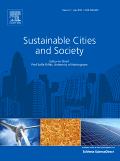
Sustainable Cities and Society
Advancing sustainable solutions for tomorrow's urban landscapes.Sustainable Cities and Society is a premier journal published by Elsevier, focusing on the interdisciplinary nexus of urban development, sustainability, and environmental challenges. With an impressive impact factor and recognized as a Q1 journal in multiple categories—including Civil and Structural Engineering, Geography, Planning and Development, Renewable Energy, Sustainability and the Environment, and Transportation—this journal stands out as a crucial platform for researchers, practitioners, and policymakers. The journal has been dedicated to advancing knowledge since its inception in 2011 and continues to be a vital resource for innovative solutions that foster sustainable urban environments. By featuring high-quality research, case studies, and reviews, it serves as an essential reference point for contemporary issues in urban planning and sustainable development. The journal's commitment to excellence is evident in its rankings, and it remains a go-to source for those invested in creating cities that are resilient, eco-friendly, and socially equitable.

Developments in the Built Environment
Exploring innovative design and engineering for a resilient future.Developments in the Built Environment, published by ELSEVIER, is a premier open-access journal dedicated to advancing knowledge across multiple facets of the built environment, including architecture, building and construction, civil and structural engineering, and computer-aided design. Since its inception in 2020, this journal has established an impressive Q1 ranking across various categories, reflecting its commitment to high-quality peer-reviewed research and its influential presence in the field, as evidenced by its strong Scopus rankings, such as Rank #7 in Engineering - Architecture. With an open-access model, it ensures that groundbreaking research is accessible to all, supporting the dissemination of innovative ideas and practices within the global community. Researchers, professionals, and students are encouraged to contribute to the discourse on sustainable design and technology, making this journal an essential resource for anyone engaged in the future of built environments.

Open House International
Shaping Innovative Discussions on the Built EnvironmentOpen House International is a distinguished peer-reviewed journal that serves as a vital resource in the fields of Architecture, Urban Studies, and Geography, Planning and Development. Published by Emerald Group Publishing Ltd, the journal circulates valuable insights and research findings that address contemporary challenges and innovations within urban environments. With an impressive 2023 Scopus ranking that places it in the Q2 category in Architecture and Q3 in Geography, Planning and Development, the journal is recognized for contributing significantly to scholarly discourse. Although it follows a traditional access model, the journal's commitment to curating high-quality content remains paramount. As it transitions into a new decade of publishing, from 2007 to 2024, Open House International continues to attract submissions that push the boundaries of knowledge in urban and architectural studies, engaging researchers, professionals, and students alike in the vibrant dialogue on the built environment.
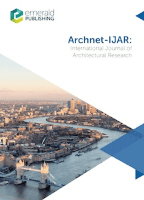
Archnet-IJAR International Journal of Architectural Research
Connecting ideas that shape the future of architecture.Archnet-IJAR International Journal of Architectural Research serves as an esteemed platform within the field of architecture and urban studies, published by Emerald Group Publishing Ltd. With an impressive impact reflected through its Q1 category rankings in both Architecture and Urban Studies, this journal highlights cutting-edge research and innovative practices spanning diverse architectural disciplines. The journal focuses on facilitating interdisciplinary dialogues, making it a vital resource for researchers, students, and professionals keen on advancing their understanding of architectural theories and urban design. With its commitment to quality, evidenced by high scores in various Scopus rankings, including a rank of 9th in Visual Arts and Performing Arts, Archnet-IJAR aims to publish work that not only challenges conventional boundaries but also enriches practical applications in the built environment. Its open-access model ensures wider dissemination of knowledge, fostering collaboration and growth within the international architectural community.
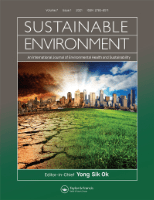
Sustainable Environment
Championing sustainability through open-access scholarship.Sustainable Environment, published by Taylor & Francis Ltd, is a pioneering journal dedicated to advancing the field of sustainability studies. Since its inception in 2021, this open-access journal has sought to provide a platform for multidisciplinary research that addresses pressing environmental challenges and sustainable practices. With a commitment to disseminating high-quality research swiftly, Sustainable Environment aims to engage researchers, policymakers, and practitioners across various domains, fostering scholarly dialogue and innovation. The journal covers a broad range of topics, including climate change, resource management, and sustainable development, making it a vital resource for anyone looking to contribute to and understand contemporary environmental issues. With its flexible access options, readers from all backgrounds can benefit from the latest insights and findings in sustainability research, thereby promoting a more sustainable future.
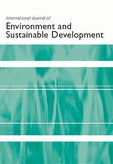
International Journal of Environment and Sustainable Development
Connecting disciplines for environmental progress.The International Journal of Environment and Sustainable Development, published by INDERSCIENCE ENTERPRISES LTD, serves as a vital platform for researchers, practitioners, and policymakers engaged in the multidisciplinary fields of geography, renewable energy, and environmental sustainability. With an ISSN of 1474-6778 and an E-ISSN of 1478-7466, this journal has been disseminating critical research since its inception in 2002 and continues to expand its scope through 2024. Recognized within the Q3 quartile in Geography, Planning and Development and Q4 in both Management, Monitoring, Policy and Law and Renewable Energy, Sustainability and the Environment, it provides valuable insights into contemporary issues affecting our planet. While access options are limited to non-open access formats, the journal remains essential for those seeking to enhance their understanding of sustainable development practices and policies in a global context. The International Journal of Environment and Sustainable Development is not only an academic repository but also a catalyst for dialogue and innovation within the environmental sciences.
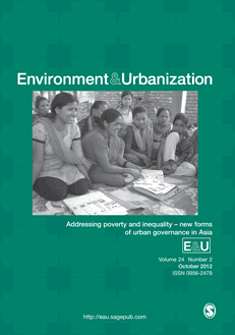
ENVIRONMENT AND URBANIZATION
Empowering research to shape the cities of tomorrow.Environment and Urbanization is a leading interdisciplinary journal published by SAGE Publications Ltd, dedicated to advancing knowledge in the fields of Environmental Science and Urban Studies. With a strong focus on the interactions between urban environments and ecological systems, this journal has established itself as a pivotal resource for researchers, professionals, and students interested in sustainable urban development and environmental management. Since its inception in 1989, Environment and Urbanization has continually provided high-quality, peer-reviewed articles that foster a deeper understanding of contemporary urban challenges, making it a highly cited publication with an impressive impact factor. As evidenced by its Q1 ranking in both Environmental Science (miscellaneous) and Urban Studies for 2023, the journal stands at the forefront of research, boasting notable Scopus rankings in its fields. By remaining committed to publishing cutting-edge research, the journal aims to influence policy and practice across the globe, ultimately aiding in the creation of more resilient and livable urban areas.
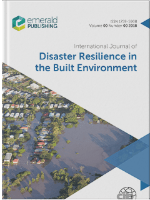
International Journal of Disaster Resilience in the Built Environment
Transforming risks into resilient solutions.International Journal of Disaster Resilience in the Built Environment is a leading peer-reviewed journal published by Emerald Group Publishing Ltd, focusing on the crucial intersection of disaster resilience and the built environment. Established in 2010, this journal serves as an essential platform for researchers, professionals, and students engaged in the fields of Building and Construction, as well as Safety, Risk, Reliability and Quality, maintaining a respectable Q3 ranking in both categories as of 2023. With a commitment to enhancing global knowledge on resilient construction practices, the journal examines innovative strategies to mitigate risk and enhance safety in built structures. Despite its robust academic reputation, it currently operates without an open access model, emphasizing its curated approach to high-quality scholarship. The publication aims to foster interdisciplinary collaboration and advance the development of sustainable practices within the context of disaster risk reduction, making it a vital resource for anyone dedicated to improving resilience in the built environment.